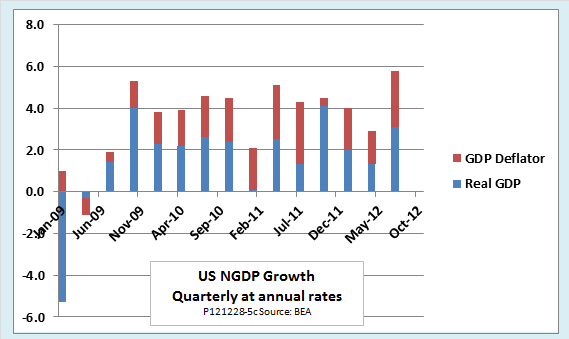Stock market today: S&P 500 climbs as ongoing AI-led rebound pushes tech higher
The third estimate of Q3 2012 US GDP came out on December 20, just as the holiday season was in full swing and as the limited public appetite for economic news was focused on the fiscal cliff. The report deserved more notice than it got. The Bureau of Economic Analysis revised its estimate of real GDP growth upward to a respectable 3.1 percent from the 2.7 percent of the second estimate, which came out in November. The latest estimate looked even better set against the anemic 2.0 percent reported in October’s advance estimate. The latest report also revised the estimate for nominal GDP growth upward to 5.9 percent, the fastest in almost four years.
The following table gives a sector-by-sector view of the revisions to real GDP. Consumption expenditure, as usual, made the largest contribution to growth, but it was a little weaker than first reported. Investment added almost nothing to growth, largely due to the drag of a massive, drought-related decrease in farm inventories. Government added even more to GDP growth than previously estimated, ending a long string of decreases. However, almost all of the growth in the government sector came from an increase in defense spending. No one expects that to be sustained as the war in Afghanistan winds down.
By far the most dramatic revision was a 56-basis-point upward revision of net exports. Exports have been a bright spot throughout an otherwise weak recovery. A reported decrease in exports—which would have been the first since Q1 2009—was the most striking feature of the Q3 advance estimate. Fortunately, once more complete data were tallied, the drop in exports turned to a moderate increase. A decrease in imports further added to the contribution of net exports. (Imports appear in the GDP accounts with a negative sign, so that the positive number in the table shows a decrease.)
Real GDP growth shows what is happening to the economy when the effects of inflation are stripped away, but as this long and slow recovery has dragged on, many economists have paid increasing attention to nominal GDP (NGDP), that is, GDP measured in current dollars without adjusting for inflation. In their view, the principal aim of monetary and fiscal policy should be to stimulate aggregate demand by enough to get NGDP back on track. When that happens, they expect real output and employment to return to healthy levels as well.
There are various ways of expressing what a healthy rate of GDP growth would be. A simple version of NGDP targeting would aim to get the economy back to its prerecession trend, represented by the dotted line in the following chart. Another approach is to calculate what the economy’s potential NGDP would be, taking into account changes in the labor force, the capital stock, the desirable rate of inflation, and other variables. The red line in the chart shows potential NGDP as estimated by the Congressional Budget Office.
The CBO estimate of potential GDP has dropped well below the prerecession trend, but not by nearly as much as actual NGDP, shown by the blue line. The difference between the potential and actual values is the country’s nominal output gap, or NGDP gap. The gap is negative when NGDP falls below its potential during a recession, and can become positive during a boom when actual NGDP temporarily rises above potential.
Progress toward closing the gap has been so slow as to be hardly visible in a chart like the one above, which shows the levels of actual and potential NGDP. The next chart, which shows the NGDP gap as a percentage of GDP, makes it easier to see what has been happening. The gap was widest, about -7.7 percent, Q2 and Q3 of 2009. By Q4 2010, it had closed to -6.05 percent, but then it widened again as the recovery stalled. In Q2 2012, the gap was -5.96 percent, only a sliver narrower than two years previously.
The new estimate of NGDP for Q3 2012 shows what could turn out to be the start of renewed progress toward closing the NGDP gap. At -5.6 percent, the gap has closed to its narrowest since Q4 2008, when the economy was in free fall. The next chart provides additional detail by breaking NGDP growth into its separate components of real GDP growth and inflation. (Inflation in this case is measured by the GDP deflator.) As we can see, in Q3 that both real GDP and inflation contributed more strongly to NGDP growth than they had earlier in the year. In fact, NGDP growth was the strongest it has been in any quarter since the recovery began.
Will the trend hold? It is, of course, too early to tell. One quarter of faster NGDP growth may be the start of a sustained improvement, or it may just be a random wiggle. The main problem at present is that monetary and fiscal policy are pulling the economy in opposite directions. The Fed is vigorously pursuing its program of large-scale asset purchases, a.k.a. quantitative easing. By itself, that provides a boost to NGDP. At the same time, aside from the one-time blip in defense spending for Q3 2012, government consumption purchases and investment, at the federal, state, and local levels, have been shrinking steadily for two years. The resulting fiscal drag is a major reason the NGDP gap has been closing so slowly.
We will know more a month from now. At the end of January, the BEA will release its advance estimate of Q4 GDP, which, although subject to revision, will give a first indication of whether recent gains in employment have translated into growth of output. Also, by that time, negotiations over the federal budget and debt ceiling will perhaps have made some progress, giving us a better idea of what fiscal policy will look like for the year ahead. Stay tuned.
Original post
